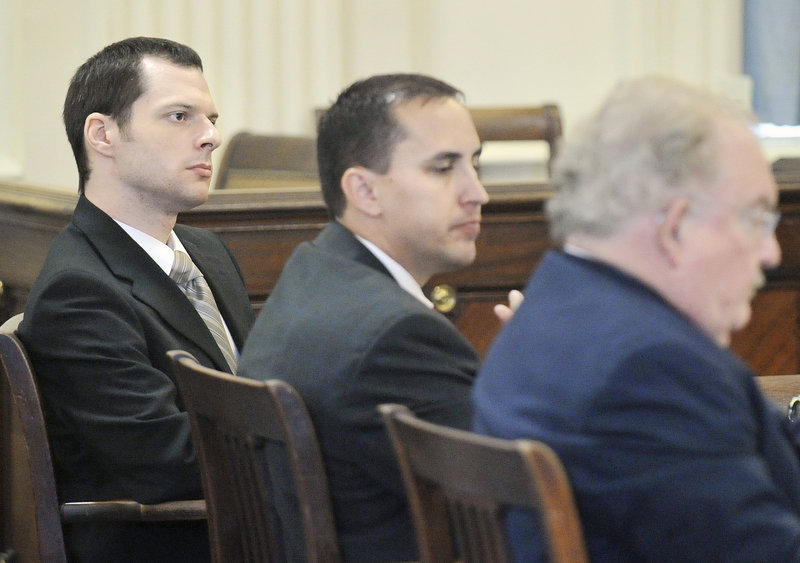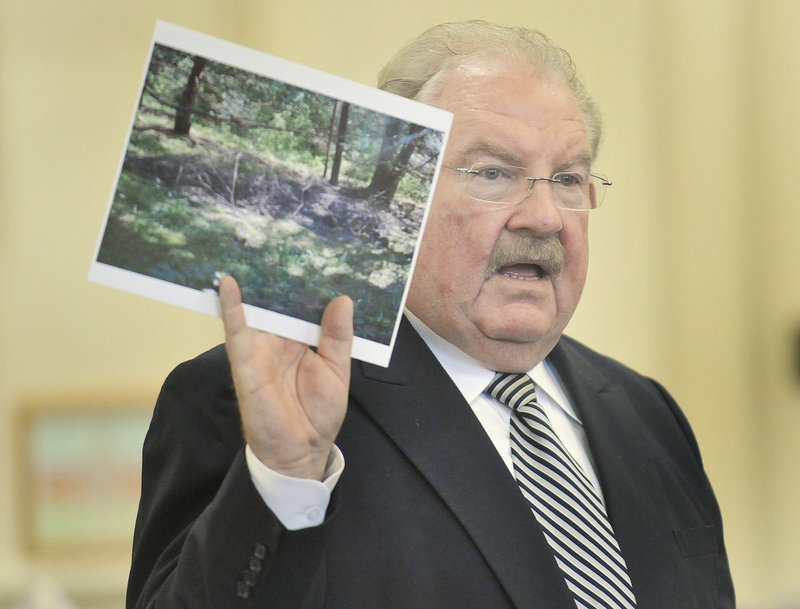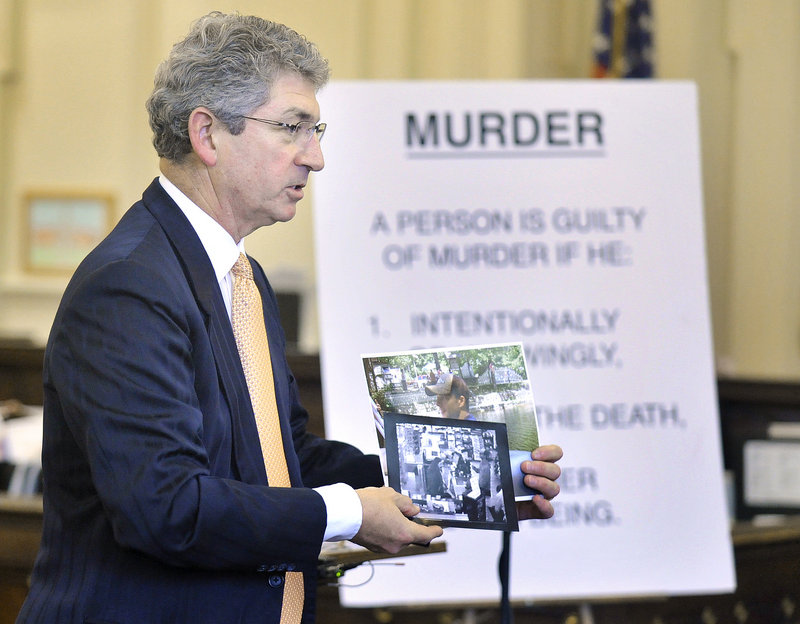ALFRED – The fate of Jason Twardus — and in some respects the future of two families that were split apart by an unimaginable crime in 2007 — now rests with a jury.
Jurors began deliberations in Twardus’ murder trial at 1:30 p.m. Thursday and discussed the case for about four hours before adjourning for the night. The seven men and five women are expected to resume deliberations this morning in York County Superior Court.
Twardus, 29, of Rochester, N.H., is charged with killing his ex-fiancee, 30-year-old Kelly Gorham, at her apartment in Alfred on Aug. 8, 2007.
Gorham was a nursing student who was known for her upbeat nature, her athleticism, and her love of animals and the outdoors. Investigators say Twardus strangled her and buried her body on a remote piece of land owned by his father in northern New Hampshire. Police found the body in Stewartstown, N.H., three weeks after Gorham disappeared.
The trial started Sept. 13 and featured more than 50 witnesses, many of whom gave wildly divergent testimony about what happened that week more than three years ago.
Closing arguments Thursday morning gave the lawyers one last chance to sway the jury.
The prosecutor, Deputy Attorney General William Stokes, came out swinging. Generally reserved in his questioning of witnesses during the trial, Stokes showed flashes of intense emotion, raised his voice often and appeared to command the otherwise silent room for nearly an hour.
“Kelly Gorham’s name has been dragged through the mud here and she doesn’t deserve it,” Stokes practically yelled, refocusing the attention on the victim.
Stokes said Twardus’ motive was simple: He could not accept that Gorham had broken off their engagement in late 2006, and she was suddenly not returning his phone calls because she had a new boyfriend.
“This is a case, ladies and gentlemen, about obsession and jealousy, two of the most powerful motives for murder,” Stokes said.
“Who has the motive? Think about it. The jilted lover. It’s as old as time itself,” he said. “She was moving on with her life without him.”
A key piece of evidence was a surveillance tape from a Big Apple store in Colebrook, N.H., recorded around noon on Aug. 8, 2007. Prosecutors said the tape shows Twardus and his car at the store, proving that he was just a few miles from the burial site, not at home in Rochester, N.H., as he told police. Defense witnesses, including Twardus, said he was not the man on the tape.
“A person looking just like Jason Twardus, wearing clothes just like Jason Twardus, and driving a car just like Jason Twardus” just happens to show up in that area on the day Gorham disappears, Stokes said.
“If Jason Twardus did not commit this crime,” he said, “it must have been a series of coincidences of cosmic proportion.”
Twardus’ attorney, Daniel Lilley, says investigators focused only on Twardus, ignoring the two people who had dinner and drinks with Gorham on the last night she was seen alive: her landlord, John Durfee, and an employee of his who was romantically involved with Gorham, Calvin DeGreenia.
Durfee, who admitted an addiction to PCP, a hallucinogenic drug known as angel dust, had no clear memory of August 2007 when he testified. DeGreenia’s previous statements to police and his testimony also were inconsistent at times. Both denied any wrongdoing.
Lilley says that Gorham was the victim of a drinking and drugging party gone bad, and that Durfee took a map to the property in Stewartstown from a binder in Gorham’s apartment, helping him to bury the body in a spot that would point directly at Twardus.
In his closing argument, Stokes said the defense’s alternate-suspect theory is not only “preposterous,” but insulting to Gorham’s memory.
“You are being asked to believe,” Stokes said, that Durfee and DeGreenia “are the brilliant masterminds in the greatest frame-up in the history of mankind.”
“You met them all. Do you really believe they are masterminds, and John Durfee is the mastermind in chief? It is ridiculous,” Stokes said.
Lilley’s approach to his closing argument was more subdued. He hit on about a dozen spots in the state’s case that he said should give the jury more than enough reasonable doubt to acquit Twardus. Lilley also countered Stokes’ zeal with some sharp one-liners.
“Mr. Stokes is a very talented lawyer, but he may be more talented at writing fiction,” Lilley said.
Lilley told the jury that the “biggest hole” in the state’s case is that prosecutors did not prove where Gorham was murdered. Under Maine law, a person can be convicted of a crime in this state only if the prosecution proves beyond a reasonable doubt that the crime was committed within the state’s borders. Lilley said there is no evidence showing whether Gorham died in Maine or New Hampshire.
“There is absolutely no evidence that this woman was killed in our state,” Lilley said. “If you don’t use the law, then you are going to convict an innocent man.”
He reminded jurors that they agreed during jury selection that they would acquit Twardus — even if they believed he murdered Gorham — if they did not believe the state had proved the crime happened in Maine.
Lilley also focused on the testimony of a neighbor to Durfee, who said he heard a party at Durfee’s property around 4:30 a.m. on Aug. 8, 2007. The neighbor testified that he heard at least one female voice and one male voice. Lilley said that doesn’t match up with the state’s timeline. Prosecutors say Twardus had killed Gorham by that time.
“That’s a fact that in this particular case should cause you to have serious reasonable doubts,” Lilley said.
He said Durfee was “evil personified.” Two women testified that he groped and sexually harassed them, and one said he spoke of taking her into the woods, raping her and leaving her for dead.
Durfee, DeGreenia and another man who worked on Durfee’s paving crew initially told detectives that they saw Gorham at Durfee’s property on the evening of Aug. 8, 2007, getting into a red car with an unidentified man.
But at the trial, they all testified that they were mistaken, and the woman they saw must have been someone else.
Lilley says Durfee and the others came up with the story about the red car as part of a plan to frame Twardus. They had to backtrack, Lilley says, after they found out that detectives believed Gorham was dead and buried by midday on Aug. 8.
“Look real hard at the last people who saw somebody alive. There is no question in this case, the last people to see her alive were Calvin DeGreenia and John Durfee, two criminals who met in prison,” Lilley said.
“Why (are police) looking at my client, and why are they letting these guys off the hook?”
Staff Writer Trevor Maxwell can be contacted at 791-6451 or at:
tmaxwell@pressherald.com
Send questions/comments to the editors.





Success. Please wait for the page to reload. If the page does not reload within 5 seconds, please refresh the page.
Enter your email and password to access comments.
Hi, to comment on stories you must . This profile is in addition to your subscription and website login.
Already have a commenting profile? .
Invalid username/password.
Please check your email to confirm and complete your registration.
Only subscribers are eligible to post comments. Please subscribe or login first for digital access. Here’s why.
Use the form below to reset your password. When you've submitted your account email, we will send an email with a reset code.